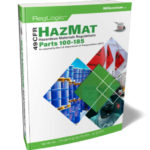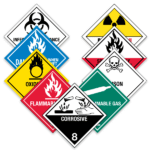
PHMSA Is Looking for Your Opinion – ANPRM HM-265A
As we leave the COVID period of the early 2020s behind, governments are playing catch-up on regulatory changes and improvements. Some rules and amendments were delayed or shelved, but now it’s time to see what new targets can be set for the future to improve the “Hazardous Materials Regulations” (HMR) of Title 49 of the Code of Federal Regulations (49 CFR).
One sign of this is an Advanced Notice of Proposed Rulemaking (ANPRM) from the Pipelines and Hazardous Materials Safety Administration (PHMSA), part of the U.S. Department of Transportation. This notice, titled “Hazardous Materials: Modernizing Regulations To Improve Safety and Efficiency” assigned the docket reference HM-265A, does not set out specific proposed changes – instead, it looks for information from stakeholders on many different topics. This can then guide PHMSA on what areas they should be focusing on and what solutions are available to current problems, such as international harmonization and an overabundance of paperwork associated with the transport of hazardous materials.
What Information Is PHMSA Looking For?
The topics under consideration by PHMSA are extensive. These are the main areas for which they’re seeking comments:
- Evaluation of whether carrier maintenance of emergency response information is required, or may be replaced with use of the Emergency Response Guidebook (ERG) or other methods
- Extending the retesting period for non-bulk packaging, intermediate bulk containers (IBCs), and large packagings (LPs)
- Steps that could be taken to harmonize American aerosol classification with that used by the rest of the world
- Should relief be provided for residue IBCs containing flammable residues?
- Revision of requirements for shipping damaged, defective, or recalled lithium batteries
- Should the training requirement be eliminated for limited quantities (as it is in Canada)?
- Do we need to adjust the requirements for a shipping paper for limited quantities transported by vessel?
- Improvements to the sampling and testing program for unrefined petroleum-based products before transportation
- Revisions to requirements for oil-spill response plan requirements in 49 CFR Part 130
- Alternate ways of communicating EX numbers for Class 1, such as a shipping document or notification, instead of marking them on packages
- Should the current exception for ethyl alcohol solutions in retail sale be extended to non-retail products?
- Division 4.3, Packing Group I materials cannot currently be shipped as “small quantities” under section 173.4 – could there be some options provided for these materials?
- Updates on procedures for shipping safety devices (such as airbags or seatbelt pre-tensioners) for recycling
- The terms “basic description” and “shipping description” are used extensively in the HMR, but are not defined specifically. Should they be to avoid confusion?
- Should the 60-day renewal requirement for approvals and special permits be removed?
- After the ValuJet crash in 1996, the U.S. created special procedures for transporting oxidizing gases by air, not adopted in the rest of the world. Should these be revised based on data since then?
- Should the data plate required for containers for marine transport under the Convention for Safe Containers no longer be required for domestic-only vessel shipments?
- Ways of providing a unique identifier for freight containers in rail transport
- Various other specific requirements for rail transport only
- Updating the requirements for passenger-carrying motor vehicles to reflect current patterns of transport
- Various possible changes to cargo tank specifications and requirements
- A review of how placards should be displayed on IBCs
- A look at new and emerging technologies that could improve hazmat transport, particularly regarding climate change
What Do You Need to Do About This?
If you ship hazardous materials to or through the United States, if you’re a carrier operating in the U.S., or even if you’re a concerned member of the public who might be affected by a hazmat incident, this is your chance to have your say at the very start of regulatory development. If you wish to make comments, you can use the following methods:
- Federal eRulemaking Portal: https://www.regulations.gov. Follow the online instructions for submitting comments.
- If you’re old-school, you can fax comments to 1-202-493-2251.
- Comments can be mailed to: Docket Management System, U.S. Department of Transportation, Dockets Operations, M–30, Ground Floor, Room W12–140, 1200 New Jersey Avenue SE, Washington, DC 20590.
All submissions must include the agency name and docket number (PHMSA–2019–0031) or RIN 2137–AF47 for the ANPRM at the beginning of the comment.
Comments must be received by October 3, 2023, to be sure of consideration. PHMSA says they will possibly look at later comments depending on how late and how extensive they are.
Questions?
ICC the Compliance Center will, of course, be watching as PHMSA progresses through the regulatory development process. If you have any questions, contact our team of experts at 855.734.5469 or send us an email, we’re happy to help.
Stay up to date and sign up for our newsletter!
We have all the products, services and training you need to ensure your staff is properly trained and informed.
 49 CFR Publications |
 UN Approved UN ApprovedPackaging and Boxes |
 Hazard Class Labels |
Sources:
Federal Register, July 5, 2023, Hazardous Materials: Modernizing Regulations To Improve Safety and Efficiency, Docket No. PHMSA-2018-0031, HM-265A
Boxhub, What is CSC? A Guide to CSC Shipping Container Certification
Wikipedia, ValuJet Flight 592






 ICC USA
ICC USA ICC Canada
ICC Canada